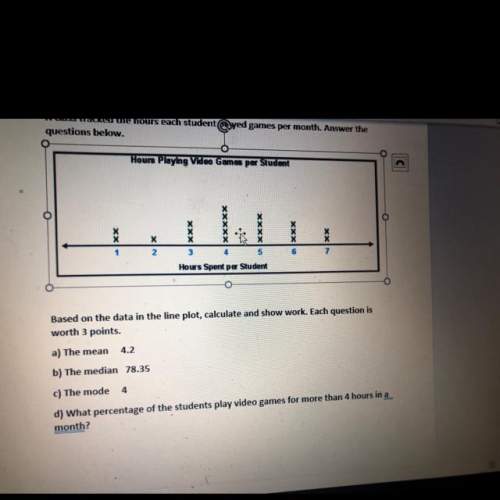
Mathematics, 22.10.2019 05:00 boos70
Use the discriminant to predict the nature of the solutions to the equation 4x-3x²=10. then, solve the equation.

Answers: 2
Another question on Mathematics

Mathematics, 21.06.2019 17:30
As part of an annual fundraiser to raise money for diabetes research, diane joined a bikeathon. the track she biked on was 1,920 yards long. diane biked 38.5 laps. her sponsors agreed to donate an amount of money for each mile she biked. how many miles did she bike? first fill in the blanks on the left side using the ratios shown. then write your answer. given ratios: 5280ft / 1 mi , 1 mi /5280 ft , 1,920 yards / 1 lap , 1 lap / 1,920 yards , 3 ft / 1 yard , 1 yard / 3 ft. blanks: 38.5 laps / 1 yard x (blank) x (blank) x (blank) = (blank) miles i'm really confused on how to do this, and the explanations aren't exactly . if you could walk me through how to do this, it would be greatly appreciated.
Answers: 1

Mathematics, 21.06.2019 21:30
Helll ! 1,400 tons of wheat of two different varieties was delivered to the silo. when processing one variety, there was 2% of waste and 3% during the processing of the second variety of wheat. after the processing, the amount of remaining wheat was 1,364 tons. how many tons of each variety of wheat was delivered to the silo?
Answers: 1

Mathematics, 21.06.2019 21:30
50 people men and women were asked if they watched at least one sport on tv. 20 of the people surveyed are women, but only 9 of them watch at least one sport on tv. 16 of the men watch at least one sport on tv. make a a two-way table and a relative frequency table to represent the data.
Answers: 3

Mathematics, 21.06.2019 23:30
Aprisoner is trapped in a cell containing three doors. the first door leads to a tunnel that returns him to his cell after two days of travel. the second leads to a tunnel that returns him to his cell after three days of travel. the third door leads immediately to freedom. (a) assuming that the prisoner will always select doors 1, 2 and 3 with probabili- ties 0.5,0.3,0.2 (respectively), what is the expected number of days until he reaches freedom? (b) assuming that the prisoner is always equally likely to choose among those doors that he has not used, what is the expected number of days until he reaches freedom? (in this version, if the prisoner initially tries door 1, for example, then when he returns to the cell, he will now select only from doors 2 and 3.) (c) for parts (a) and (b), find the variance of the number of days until the prisoner reaches freedom. hint for part (b): define ni to be the number of additional days the prisoner spends after initially choosing door i and returning to his cell.
Answers: 1
You know the right answer?
Use the discriminant to predict the nature of the solutions to the equation 4x-3x²=10. then, solve t...
Questions


English, 06.12.2019 02:31

Mathematics, 06.12.2019 02:31



Mathematics, 06.12.2019 02:31


Mathematics, 06.12.2019 02:31


English, 06.12.2019 02:31

English, 06.12.2019 02:31


Mathematics, 06.12.2019 02:31


Health, 06.12.2019 02:31


Mathematics, 06.12.2019 02:31

Mathematics, 06.12.2019 02:31










